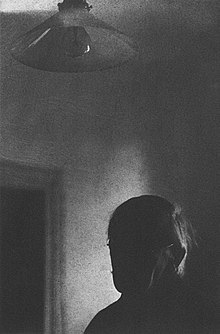Bohuslav Reynek
Bohuslav Reynek (born May 31, 1892 in Petrkov , Bohemia; † October 28, 1971 ibid) was a Czech poet, writer, graphic artist, painter and translator.
Life
In the years 1904–1911 Bohuslav Reynek attended high school in Jihlava , where he learned French and German. After briefly studying at the Czech Technical University in Prague, he returned to Petrkov. In 1926 he married the French poet Suzanne Renaud , whose work he later translated into Czech. In 1914 he began his long and close collaboration with Josef Florian from the Stará Říše community (then Alt Reisch), where he translated, illustrated and published his own poems. He and Suzanne had two sons, Daniel (born 1928; died 2014) and Jiří (born 1929; died 2014). After the communist coup in 1949, his homestead was confiscated (he and his family were allowed to live in Petrkov) and the publishing houses that had previously published his work were closed. He died on his farm in 1971 and was buried in the family grave in Svatý Kříž's cemetery.
poetry
Reynek's poems are meditative and inspired by the Czech countryside, rural life and deep Christian humanism. What is remarkable is the delicate way in which religious themes are broken up by images of his immediate surroundings; the poems lay everyday objects and scenes (like the farm animals, their stables, the rhythms of the working week) with a spiritual, delicate luminescence. For the most part, he uses traditional forms with original rhymes.
Reynek's books were banned under communism and those in public libraries were liquidated because of Reynek's Christian faith. He died poor, but served as a role model for young Czech poets of the 1960s and 1970s, including Ivan Martin Jirous , Zbyněk Hejda and Ivan Diviš . His last work - Odlet vlaštovek - was published posthumously abroad. After 1989 the Torst Verlag in Prague published a critical edition of his poems. The French author Sylvie Germain wrote Bohuslav Reynek à Petrkov (1998), a meditation on his life and his art.
Reynek was a translator for French and German. Among the poets he translated was the Austrian expressionist Georg Trakl , and an influence of Trakl's techniques can also be seen in Reynek's own texts. The translations of Trakl's poetry volumes Poems (1913) and Sebastian im Traum (1915) ( Básně 1917; Šebastian v snu 1924) are the world's first translations of Trakl's poetry into a foreign language. Reynek translated French Catholic poets such as Léon Bloy , Jean Giono , Francis Jammes , Jean de La Fontaine and Paul Verlaine .
Graphics and painting

During his studies at the secondary school in Jihlava, Reynek began to devote himself to drawing and painting. The oil painting Portrait of the Father (1911) has survived from this period . He made contact with members of the Osma and Mánes groups, and later with the Tvrdošíjní group .
In the 1920s he created expressionist linocuts in connection with the publisher Joseph Florian. Reynek worked with Josef Čapek and Vlastislav Hofman on the publication of his own edition of poetry . In the years 1927–29 he exhibited his drawings, pastels and etchings at several exhibitions in France, where his work was well received. Art was his main source of livelihood during this time.
In 1933 Reynek tried drypoint etching . Since then, these graphics have dominated over charcoal and pastel drawings. Between 1933 and 1971 he produced more than six hundred graphic sheets using drypoint or etching technology.
In the 1930s, Reynek's graphic art dominated the landscape. From 1939 he turned to biblical motifs. During the Second World War, the most common motifs are crucifixion, piety, and the denial of Peter . The Passion Cycle also dates from this time. Reynek produced most of his graphic work in the 1950s and 1960s, for example the Job cycle (1948–1949), the Don Quixote cycle (1955–1960) and a number of other graphics.
Like his poetry, his graphics only gained full recognition after the fall of the communist regime in the 1990s.
Volumes of poetry
- Žízně (Dürste) (1921), poems
- Rybí šupiny (Fish Scales ) (1922), poems in prose
- Had na sněhu (Snake on the Snow) (1924), poems in prose
- Smutek země (Mourning the Earth) (1924), poems
- Rty a zuby (lips and teeth) (1925), poems
- Setba samot (Sowing of Solitude) (1936), poems
- Pieta (1940), poems
- Podzimní motýli (Autumn Butterflies ) (1946), poems
posthumously:
- Odlet vlaštovek (Flight of the Swallows) samizdat (1978) (Munich 1980), many issues after 1989,
- Vlídné vidiny (Kind Visions), Ed. Jaromír Zelenka (Odeon, 1992)
- Complete edition of the poems: Básnické spisy (Poetic Works), Ed. Marie Chlíbcová (Archa / Petrkov, 2009)
English translations:
- Bohuslav Reynek: Fish scales . trans. Kelly Miller and Zdenka Brodská (Ann Arbor: Michigan Slavic Publications, 2001).
- Bohuslav Reynek: Shadows . trans. Justin Quinn, New Yorker (2011).
French translation
- Bohuslav Reynek: Le serpent sur la neige . trans. Xavier Galmiche (Grenoble: Romarin-les Amis de Suzanne Renaud et Bohuslav Reynek, 1997). See the Romarin publisher's catalog.
| personal data | |
|---|---|
| SURNAME | Reynek, Bohuslav |
| BRIEF DESCRIPTION | Czech poet, writer, painter and translator |
| DATE OF BIRTH | May 31, 1892 |
| PLACE OF BIRTH | Petrkov, Czech Republic |
| DATE OF DEATH | October 28, 1971 |
| Place of death | Petrkov, Czech Republic |
